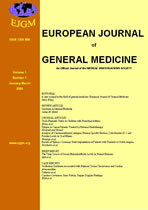
|
European Journal of General Medicine
Medical Investigations Society
ISSN: 1304-3897
Vol. 6, Num. 1, 2009, pp. 60
|
European Journal of General Medicine, Vol. 6, No. 1, 2009, pp. 60
Brief report
Antibiotic Treatment Failure in Chronic Nosocomial Wound Infections
Basavraj Nagoba1, Shirish Kolhe2 , Bharat Wadher3
Maharashtra Institute of Medical Sciences and Research, Medical College and Hospital, Departments of Microbiology1 and Pharmacology2, Latur, Medical Microbiology Research Lab. Nagpur University, Nagpur3, India
Correspondence: Nagoba B. S. Asst. Dean, Maharashtra Institute of Medical Sciences and Research, Medical College and Hospital, Latur 413 531 (M. S.) India Mobile: 91- 09423075786 E-mail:dr_bsnagoba@yahoo.com, bsnagoba@indiatimes.com
Code Number: gm09015
In recent decades, Pseudomonas aeruginosa, Staphylococcus aureus, Escherichia coli, Klebsiella spp, Proteus spp, etc. have emerged as the most notorious nosocomial pathogens. Their ability to develop resistance to antimicrobial agents make them main culprit as aetiological agents in numerous infections especially in nosocomial infections. Their capabilities to colonize rapidly in a compromised host make them very difficult to deal with. In such an eventuality antibiotics stand ineffective.
As has been observed in recent times, nosocomial infections have posed grave challenge to the clinicians. This problem can be attributed mainly to the growing resistance to a wide spectrum of antibiotics. Here is an interesting observation on 11 cases where P. aeruginosa, Staphylococcus aureus, Escherichia coli, Klebsiella pneumoniae and Proteus vulgaris were the causative organisms, susceptible to antibiotics, but the use of specific antibiotic did not yield any results. In a case of pseudomonal wound infection, the culture and susceptibility study had shown P. aeruginosa susceptible to ceftazidime. Based on the report, the patient was given injection ceftazidime 500 mg eight hourly for seven days but still the wound didn’t respond. Reculture and repeat susceptibility studies after seven days again revealed susceptibility to ceftazidime with P. aeruginosa as the culprit bacteria. Similar observations were made in 10 other cases of nosocomial wound infections caused by Pseudomonas aeruginosa, Staphylococcus aureus, Escherichia coli, Klebsiella pneumoniae, and Proteus vulgaris with susceptibility to different antibiotics but no response to administration of the indicated antibiotics. Though resistance to antibiotics is the chief reason for the treatment failure in many cases. Our observations are interesting where treatment failed though the isolates were susceptible to the administered antibiotics. The reason for treatment failure could be different like inappropriate and inadequate antibiotic therapy, drug-drug and drug-patient interaction, poor patient compliance or poor diffusion of antibiotic due to clotted fibrin and so on. At times chronic granulation tissue leads to inadequate tissue levels of antibiotics so the bacterial levels in granulating wounds may not be tackled properly (1-3). These results indicate that systemic antibiotic therapy may not have practical and potential value in the treatment of nosocomial wound infections without systemic symptoms. So the local wound care in such cases remains the backbone of treatment instead of the systemic antibiotic therapy, especially in chronic wound infections. REFERENCES
- Borcherding SM, Stevens R, Nicholas RS, Corely CR & Self T. Quinolones: a practical review of clinical uses, dosing considerations & drug interations. J Fam Pract 1996; 42:69-78
- Kinghton DR, Halliday B & Hunt TK. Oxygen as an antibiotic: A comparison of the effects of inspired oxygen concentration and antibiotic administration on in vivo bacterial clearance. Arch. Surg 1986; 121:191-195
- Robson MC. Wound infection–A failure of wound healing caused by an imbalance of bacteria. The Surgical Clinics of North America 1997; 77:637-650
Copyright 2009 - European Journal of General Medicine
|
